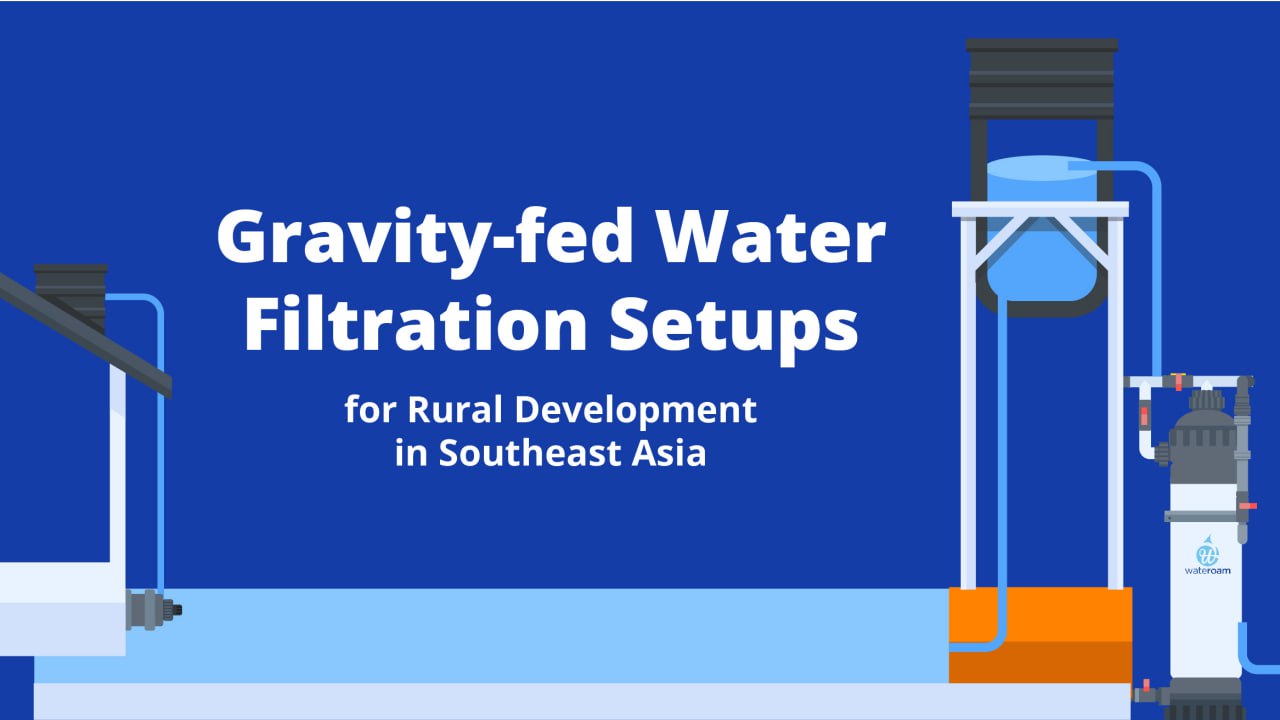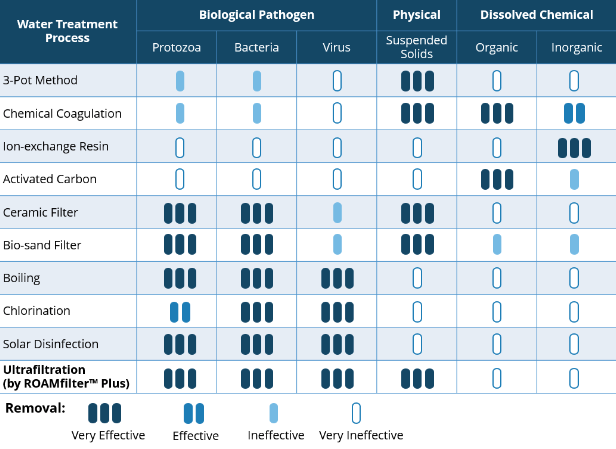Gravity-fed Water Systems: Purification and Filtration Setups in Southeast AsiaDuring prolonged droughts or similar emergencies, storing enough water for people's daily needs is a matter of life and death. Gravity-fed water systems, such as water towers, are one way we can help communities with water storage and distribution. More clean water storage closer to rural communities saves people time and keeps them healthy. But before you and your team embark on your next rural water project, we want to share a few points on gravity-fed water systems, such as:
What is a gravity-fed water system?A gravity-fed system consists of a water tank, cistern, or reservoir at a higher elevation than the water outlet. The difference in height lets gravity provide the system with water pressure to the lower water outlets. Water towers with access to the municipal water and electrical grid are refilled at night when electricity and water usage are lower. During the day, the tower releases gravity-pressurised water during peak usage periods. This arrangement evens out pumping requirements and can even decrease pumping power costs in cases where electricity is charged differently during peak or non-peak periods. In off-grid systems, solar or mechanical pumps can pump water into the water tower. Some systems use natural gravity, filling the water tank from a water source further uphill. The article about a rural water system in Sabah discussed below uses such a system. Gravity-fed water systems also supply water during emergencies like prolonged power outages, droughts, fires, etc. (1) Now that we’ve gone through the basics of gravity-fed water systems, we cover whether rural communities need this solution: A Snapshot of Water Issues and Solutions in Southeast AsiaIn some communities, water sources tend to be far away, forcing people to fetch water manually. When the adults who typically fetch water fall ill, it can lead to people having to forsake school or work to get enough water for their families. In other situations, the lack of infrastructure or changes in climate can cause nationwide water shortages. Here are some stories of water issues and storage solutions from Southeast Asia:
This article highlights some of the issues causing the Philippines’ water crisis. Geographical distribution of water: “In a 2021 report, the National Economic and Development Authority (Neda) said water supply in the country is unevenly distributed because of rainfall variability, besides the size and features of each island.” Dry Seasons: “In previous years, parts of the country would experience water service interruptions for weeks due to the El Nino phenomenon, when an extreme rise in temperature with little rainfall affects water levels in the dams from which households source water.” Water theft and inadequate water management practices: “The government has been criticised for having inadequate water management practices that fail to stop illegal tapping activities and pipe leaks that contaminate the water supply.” Polluted sources of water: “Neda said surface water and groundwater in some areas remain contaminated because of open defecation, and improper management and disposal of human excreta and blackwater. These practices expose communities to waterborne diseases.” In cases like these, there is demand for water storage systems with purification to help alleviate the Philippines’ water crisis, especially in rural areas.
In Indonesia’s East Nusa Tenggara province, the NTA East Indonesia Aid works in the islands of West Timor and Flores where 30 percent of people live below the national poverty line. “The region experiences low rainfall and a dry season spanning up to nine months of the year, with recurrent famine-like conditions affecting agricultural productivity, people’s health and their ability to generate income.” To combat this, NTA works with local foundations and farming collectives to provide and construct 15,000-litre water tanks for members of these collectives. As a result, families no longer need to collect and carry water home from public sources, which lets them spend more time earning income. The extra water also benefits their agricultural activities.
To provide a clean water supply in the interior of Sabah Joe Primus Kayau came up with a gravity water filter system that can produce up to 200,000 litres of clean water a day. His system obtains clean water from natural sources above the villages by maintaining the authenticity and integrity of natural drainage. Initially, his idea was only used in his village. His idea eventually caught the attention of Sabah’s State Rural Development Minister Datuk Jahid Jahim and the Rural and Regional Development Ministry to implement his ideas in several other rural areas in Sabah. There is still a lot we need to do to provide adequate access to clean water for everyone. Within Southeast Asia, there are countries where less than 50 percent of their population can access safely managed drinking water services, including Indonesia and the Philippines. Projects that build water storage and infrastructure to support rural communities can go a long way to solve this issue. Managing Water Quality in Gravity-fed Water Systems: Water Purification and FiltrationIdentifying Water Sources and Monitoring Water QualityBefore beginning the project, it helps to figure out what are the needs of the community and what their water storage needs are. You can start by identifying water sources that provide enough water for the community and test their water quality. Water quality differs from area to area, so you’ll need to look out for various types of contaminants:
These are different types of water quality tests that adhere to WHO water quality standards. For detailed chapters on these standards, you can visit the latest WHO guidelines and check out our article on water standards. Our company, Wateroam also sells water test kits that can help test for 10 factors:
Contamination and quantity concerns are just two of many other considerations for the water storage project. Below are a few questions from the 2018 Sphere handbook’s initial checklist on water supply (page 140):
There are more questions in the list which also includes water purchases, hygiene issues and questions about traditional beliefs about water. We highly recommend viewing the Sphere handbook before you begin your project. Selecting purification methodsAfter identifying the contaminants in the water, you can select appropriate water purification methods for your community. There are various water purification methods you can use to deal with different types of water contamination: You can find more details on different contamination and filtration types on our water FAQs page. Depending on the water quality, one or more water treatment processes will be needed to ensure water quality for your community. For example, you could use a combination of chlorination to disinfect the water and chemical coagulation with water filtration to remove any fine particles and remaining microorganisms in the water. From our experience, many of the communities that we visit face microbiological contamination in the water, resulting in diarrhea, dysentery, typhoid, and other waterborne diseases regularly. In cases like these, we have found that ultrafiltration as a purification method can safely eliminate these contaminants and provide sufficient clean drinking water for the communities that we’ve supported. Below is what a gravity-fed water system looks like with the ROAMfilter Ultra attached to the water intake of this water tower: Selecting the Right ComponentsThe core components of a gravity-fed water system include: (5)
The tank’s size should factor in the community’s peak usage rates and emergency consumption needs. Non-food grade water tanks are sufficient for non-potable uses like agriculture. We’ve also compiled some considerations for the water storage tank’s material below: (6) Plastic Water Tanks Advantages: Plastic tanks are affordable, widely available, and made from polyethylene which balances flexibility and brittleness. They have good resistance to light impacts and are easily repairable and resistant to corrosion, especially from salt water. Disadvantages: Heavy impacts and prolonged sunlight exposure can damage plastic water tanks. Certain plastics, like plasticised PVC, may leach harmful chemicals into the water, making them potentially unsafe for potable water. Plastic tanks have limited recyclability and can promote algae growth under certain conditions. Aqua-Plate and Galvanized Steel Water Tanks Advantages: These tanks are durable, lasting up to 40 years with proper care, and have good resistance to corrosion thanks to internal zinc coatings. Disadvantages: They are unsuitable for storing corrosive water as it can reduce lifespan. Repairing these tanks can compromise their protective coatings, and even small leakages can lead to significant corrosion over time. Their resale or scrap value is also limited. Stainless Steel Water Tanks Advantages: Stainless steel tanks are highly durable, corrosion-resistant, less hazardous for water storage, and relatively easy to repair. They experience slow-paced corrosion, maintaining value over time. Disadvantages: The main drawback is the high initial cost, making them a more expensive option compared to other materials. Concrete Water Tanks Advantages: Concrete tanks are highly durable, easy to recycle, and offer great thermal resistance, making them suitable for a variety of uses beyond just water storage. Disadvantages: They are prone to leakages, difficult to repair, and their heavy weight makes them hard to maneuver. The lime content can increase the pH level of stored water, posing health risks. Fiberglass Water Tanks Advantages: Fiberglass tanks are impact resistant, easy to repair for those with the right skills, resistant to climatic changes and corrosion, and have a good durability of 30 to 40 years. Disadvantages: They are difficult to recycle and may release harmful substances over time if not correctly lined, posing potential health risks. Bladder Tanks Advantages: Bladder tanks are large, flexible, suitable for storing various liquids, mobile, and can be used in diverse settings while protecting liquids from contamination. Disadvantages: Their main vulnerability is puncture damage, requiring careful installation and maintenance to prevent leaks. We’ve included a resource in the hub below that elaborates on water consumption and the terms to use in the appendix (Workforce Libre).
For reference, for every 10m elevation head, you get approximately 1 bar of pressure. Metre head refers to the height at which a pump can raise water or reverse it, how much pressure is generated when the storage tank is above the water outlet. Gravity-fed water systems are not limited to using water tanks. Reservoirs like lakes on hills also count as elevated water sources.
Off-grid setups can use alternatives like solar or mechanical pumps to feed the water tank. A pump may not be required if the water source is higher than the water tank, such as a water spring on a hill. The pump can be manually activated or automatically activated via a float valve in the water tank or an electronic device.
Other components in gravity-fed water systems you can include:
Maintaining the Water SystemThe Sphere Handbook’s initial checklist for water supply also includes this question on system maintenance:
To ensure the system can be sustainably maintained by the community, you need to identify and train both caretakers and the community's stakeholders to manage hygiene practices and water system maintenance. Ideally, the caretakers can pass on this knowledge to other community members and can operate reliably without needing further intervention. In Wateroam’s case, our teams work with partners like Safe Water for Every Child Myanmar who teach the community members like teachers about water, sanitation and hygiene practices in addition to filter care methods like periodically backwashing the system. Water tanks need to be periodically cycled. This is because storing too much water in the tank for too long can cause water quality degradation. Chlorine residuals can diminish and water can stagnate if the stored water is not changed. You can prevent these issues by teaching the community stakeholders how to cycle the tank. (8) In Conclusion Gravity-fed water systems are an important way to store water for emergencies while also helping to regulate water and pump usage. With multiple threats to water security including dry seasons, uneven distribution of water over geography, polluted water sources, and even water theft, improving water storage in rural areas can help alleviate water crises in many places. When planning your next rural development project, remember to test your water supply sources and plan the right purification methods for your community. You can also work with the community to plan for periodic water cycling to prevent water stagnation. We hope you’ve found this guide useful for planning your next water project. If you want to speak with us for a water project consultation or want to find out more about how our water filters help out rural communities, you can reach out to us below: You can also find other helpful resources here:
References:
0 Comments
Leave a Reply. |
Want more?Click below to see what other blog topics might peak your interest. 


|
- About Us
- Products
- Solutions
- Resources
- Get Involved
-
Blog
- The Global Water Situation
-
Facts about Water
>
- Water supplies for crisis
- WaSH During Emergencies
- Well Water Cleaning and Filtration Guide: Southeast Asia
- Gravity-fed Water Systems: Water Purification and Filtration setups in Southeast Asia
- A Guide to Rural Rainwater Harvesting and Filtering
- Water Shortages and Their Effect on Children in Rural Schools
- WaSH Planning and Design Framework Resources for Indonesia and the Philippines
- Rural Community Water Supply: Water Systems in Villages
- Info on our Products
- Impact Stories
- Upcoming & Past Events
- Contact
- Store
- About Us
- Products
- Solutions
- Resources
- Get Involved
-
Blog
- The Global Water Situation
-
Facts about Water
>
- Water supplies for crisis
- WaSH During Emergencies
- Well Water Cleaning and Filtration Guide: Southeast Asia
- Gravity-fed Water Systems: Water Purification and Filtration setups in Southeast Asia
- A Guide to Rural Rainwater Harvesting and Filtering
- Water Shortages and Their Effect on Children in Rural Schools
- WaSH Planning and Design Framework Resources for Indonesia and the Philippines
- Rural Community Water Supply: Water Systems in Villages
- Info on our Products
- Impact Stories
- Upcoming & Past Events
- Contact
- Store







.jpg)